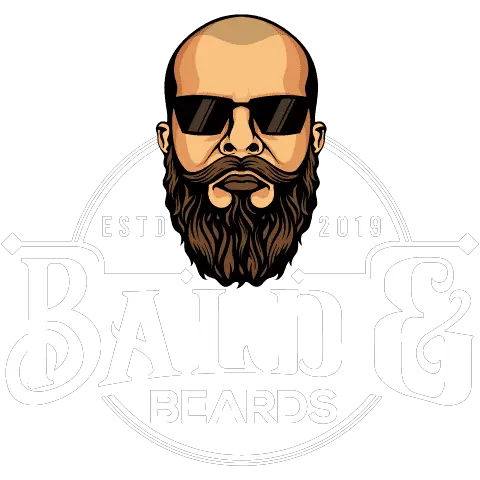Want a thick, well-developed beard? It’s not always as easy as “don’t shave for a week,” but many people share this misconception. So, simply halting your shaving won’t always transform your sparse facial hair into perfect beard growth.
Uneven or patchy beard growth isn’t uncommon and can be caused by several factors. Things like stress, poor diet or a hormone imbalance may be affecting facial hair production. Fixing beard patches can be as easy as growing it out, grooming, better nutrition and cosmetics.
It’s all about finding the best fit solution for your beard style. Read on to find out more.
Patchy Beard Causes
As I mentioned, there’s nothing to be ashamed of if your beard is patchy. Most men are unable to grow a full beard in just a week or even two weeks. In fact, it takes months or even years to grow a medieval Lord-like beard – AKA Yeard Beard.
So how do some men seem to have a fuller beard in just a month or two? There are some reasons why your beard hasn’t fully developed and ways (below) to achieve thicker facial hair.
See our New Patchy Beard Style Guide
Understanding Patchy Beard Growth
Patchy and uneven beard growth is a common issue. It can be as simple as dietary problems or hormonal imbalances, but most of the time, it’s your hair genetics. Some doctors have also found that fungal infections may lead to hair loss along the jaw and cheeks.
If you’ve always had an uneven beard, then it’s likely a family trait, but if you could grow a beard faster before, then the patches are new. This could be a sign of something else, such as a disease or a deficiency.
Seeking a doctor’s opinion is the best option if your hair isn’t coming in as thick as before.
Age Affects Beard Growth
Patches indicate puberty problems when trying to grow a beard in your teens. It can even be difficult to match the full beards of older men when you’re in your twenties.
Since males mature at different rates, you may notice your friend’s beard grows faster. However, most men have a propensity to grow thicker beards over the age of 35. Beards get denser with maturity.

Patchy Beard from Stress
Stress can cause problems for men who want to grow a thick beard. Reducing stress enhances overall hair growth.
This is because of cortisol, which is a natural hormone, can decrease testosterone levels in the body. It also causes problems by constricting your blood vessels. Both can lead to lack of hair along your jawline and cheeks.
How to Fix a Patchy Beard
Filling in a patchy beard is a process. Even if you have genetics leading to alopecia areata or male pattern baldness, you can still grow a full beard. One thing that many men make the mistake of doing is quitting on a beard before allowing it to grow. There are several stages of beard growth that happen over months and years.
Besides changing your diet and other tips in this list, you also may need to invest in beard growth kit, which includes combs, oils, and shampoos that make it easier to grow your beard longer and thicker.
1. Let it Grow Out
Did you know that it typically takes 30 days to see longer beard growth? When you have an uneven beard, the first stage is the hardest. Day after day, your stubble grows, but it may not be coming in thick along your cheeks or certain areas along your jaw.

However, resist the urge to trim or shave down beard stubble. You should grow your beard as freely as possible for a month. During this time, you may a cleaner neckline and trim areas where you don’t want to grow hair such as longer neck hairs and throat stubble – AKA a neck beard.
Hair should eventually grow over the patches of hair, becoming more thick the longer you resist shaving.
2. Good Grooming
During the first hair growth stage, foster new hair growth by helping your follicles stay at their best. This means looking out for dry skin underneath your beard that will definitely cause an itchy beard.
There are a few things that you can do to get a brittle, wiry beard under control. Here are some quick beard care tips:
Use beard oil
These oils help you moisturize your skin and keep your hair follicles healthy. If you can see your hair is breaking and lacks shine, then beard oil or leave in beard conditioner will definitely help.
Use Beard Balm
There are plenty of grooming kits for beards that contain great beard balms. Sometimes these are shampoo or conditioning balms. However, they’re mostly used to help your hair grow in the right direction.
Smooth and breathtakingly lovely to smell, balms are the best way to shape your beard without a trimmer.
Brush your Beard Daily
You can use a bristle style beard brush to shape your beard hair. Brushing downwards to cover patches may lead to more hair growth in the direction you want. Brushes also help you keep your hair tidy and well-tamed.
If you have issues growing your hair even after using these products, there are more aggressive ways to sponsor hair growth.
3. Try a Shorter Beard
Many celebrities have dealt with an uneven beard before. Johnny Depp and Bruce Springsteen have rocked the look for years. See more celebrity beards.


The key is to keep these beards trim and short in certain areas. As your beard hair grows, you’ll begin to notice a thicker beard. If you manage your beard so it’s even as it can be, then bald spots won’t stick out as much.
Pay Attention to the Lines
Even if you have uneven or patchy spots, you can pick out certain lines to make it even. This leads to a cleaner cut and professional look.
Barbers may also trim and fade your beard to help with the patches until your hair comes in thicker. If you keep the border lines of your beard neat, then your cheekbones and jawlines will stand out more, too. You can use a beard trimmer to get this professional look.
4. Embrace your Look
We’re all unique in our own way. I also have patches throughout my beard and jawline. Now, I’m fortunate I can grow a longer length where the thin spots aren’t noticeable. However, I’ve also become comfortable even when my beard is short.
See Keanu Reeves’ patchy beard at the John Wick premiere. Now that’s confidence!

5. Good Nutrition
Do you need a patchy beard fix? You may think the problem is with genetics, but it could also be your diet and lack of vitamins.
A healthy lifestyle with lots of vitamin D exposure, such as working out under the sun, is an important first step. Studies have found that these vitamins and minerals are responsible for hair growth and the most problematic if missing from your diet:
- Biotin
- Vitamin A
- Vitamin D
- Iron
- Zinc
- Niacin
- Vitamin C
- Vitamin E
Taking vitamins and supplements may be the one thing to help you get a fuller beard. For example, a multivitamin with niacin may be just the thing to help.
It’s no secret that improving your diet helps beard growth. So, there are some super foods you can eat to help simulate a healthy beard. Egg yolks, avocados, almonds, cauliflower, bananas, sunflower seeds, spinach, kale, squash, blueberries, oranges, mangos, and lean protein such as salmon can truly improve hair follicles and growth.
6. Fill In Patchy Spots
Patchy facial hair doesn’t have to look so prominent. There are tricks to passing off a thin beard as thicker.
As any stylist can tell you, men shouldn’t be afraid to fill in small areas with a beard filler pencil.
Women have been performing a similar practice on their eyebrows and hairlines with an eyebrow pencil for decades with.
You can also comb your beard to hide small patches and go over it with a styling balm to ensure that it stays in place. You may also want to dye your beard if you notice that it’s much lighter than your hair color or has grey strands. Lighter beard hair may contribute to the patchy look.
7. Minoxidil for Patchy Beards
Though not a natural remedy, Minoxidil products promote hair growth, most notably on your scalp. It’s also shown to be a good patchy beard treatment and Minoxidil for beard growth is a viable option.
However, if applied to your skin around your cheeks and jawline could lead to dryness and peeling. You should your skin become dry, you can try beard oils & conditioners specifically made for facial hair to avoid these issues.

Wrapping Up: How to Grow a Thicker Beard
If you feel like your hormones are out of whack and you’ve been trying to grow a thicker beard for some time, then you may want to seek help from a doctor. Blood tests may show what hormones are causing the issue and whether you have any deficiencies, such as iron or niacin, that are making the problem worse.
- Exercise more
- Quality beard products
- Cosmetic fillers
- Get plenty of sleep
- Lower your stress


